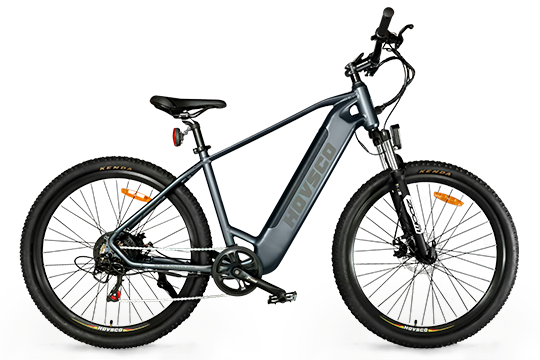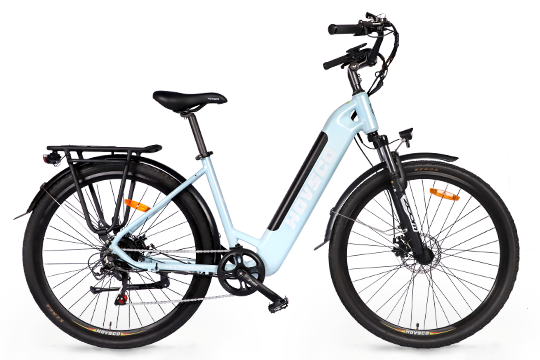Everything You Need to Know about Frame Material of Electric Bikes

There are so many ebikes on the market right now that it's unbelievable. Although most ebikes have alloy frames, there are also a few with carbon frames and even a few with steel frames. Today we'll discuss the different types of bike frame materials on the market, as well as the design of e-bike frames. In total, there are more than a dozen frame materials, but we will focus on the four most common and the characteristics they have. You will be able to better understand the differences between various e-bikes with this new knowledge.
Aluminum Electric Bike Frame
Aluminum is now less expensive and very widely used on bikes, having come a long way from the oversized tubes of old. It's light, strong and stiff. The design can provide a solid ride for climbing, or lively handling in tight situations, but that also means that it has a lower weight threshold.
The most commonly used grades of aluminum alloy material for bike tubing are 7005 and 6061. Generally, 6061 aluminum is solution-heat treated, then aged. T4 temper aluminum is naturally aged, and T6 temper aluminum is artificially aged. Therefore, heat-treating 6061 T6 aluminum alloy further increases its strength properties. The heat treatment process is crucial. After welding, it relieves material stress and can affect the material's tensile strength and ductility while preserving its stiffness.
Carbon Fiber Electric Bike Frame
Carbon fiber has been used on bicycles as a high-tech material for the last ten years. Strictly speaking, carbon fiber is not just carbon, but a mixture of carbon elements bonded and reinforced with epoxy resin after weaving. Early carbon fibers, due to technical reasons, used epoxy resins that even decomposed in sunlight. With the advancement of technology, the shortcomings of this excellent material are gradually overcome. For example, the K frame in Germany uses advanced 16K carbon fiber. The strength of this carbon fiber is even more than that of steel, and it has a quality guarantee for life.
In many ways carbon fiber is the ultimate material for making ebikes. It is incredibly light and strong compared to anything else. And it has a good shock absorption performance too, effectively absorb vibration and maintain good rigidity.
It can make frames of various shapes. Different from the manufacturing process of ordinary metal frames, carbon fiber frames are generally made of molds first, then carbon fiber sheets are placed on the molds, and finally epoxy resin is used for fixing. This manufacturing process can use aerodynamics to make a frame with minimal wind resistance.
Steel Electric Bike Frame
Steel bike frames used to be the norm, but as other material alternatives have improved, steel frames have been falling more out of favor year after year. Steel is more durable than aluminum, and it isn’t as expensive or difficult to work with as carbon fiber or titanium. In fact, steel is the most easily repaired kind of frame and has superior corrosion and fatigue resistance compared to aluminum. Steel is still popular with cross-country cyclists since the shock absorption provides a very smooth ride even without additional suspension support.
However, the major downside to steel frame bikes is they are the heaviest material to work with. Electric bikes are already heavy due to the motor, electrical wiring, battery, and other components required to make an eBike function. Depending on the design, a steel frame eBike weighs 80, 90, and occasionally over 100 pounds.
That’s just too much for the typical cyclist to lift or handle by themselves. While you are saving a little money, the total savings are minor compared to the much better performance and weight of carbon fiber or titanium eBike.
Titanium Electric Bike Frame
Titanium is a material that hasn’t become too popular with the general eBike manufacturing industry yet, but it is a prevalent option for custom bike builders. Titanium is close to steel in terms of performance but has higher corrosion resistance and the best strength-to-weight ratio across the four popular eBike frame materials.
Titanium is more straightforward to repair than aluminum and carbon fiber, and it offers a smoother ride than both of them. Titanium is so tough and long-lasting; a couple of bike manufacturers offer a lifetime warranty protecting the bike against defects, a true mark of how confident bike manufacturers are in their design and performance.
The biggest downside to titanium Ebikes is that they’re hard to find and work with, making them some of the most expensive bikes on our list. Titanium also varies in quality, so if you buy a used bike or one custom-made by someone without any supervision, you might wind up with a weaker eBike frame than even a standard aluminum model. Titanium also struggles with electrical wiring integration more than the other frame options, which further drives up the price. (In our previous post about Ultimate Bike Commuting Guide for Women, you'll find more helpful thoughts.)
Now that you know the four most common e-bike frame materials, you can compare different models and designs. Look for a bike that is lightweight, with clean welds, and consider its price and the amount of time you plan to use it. An affordable aluminum frame might be just as good as an expensive carbon fiber frame, and will save you a lot of money!
There are a number of frames available that will accommodate most riders and can be equipped with racks and accessories like these to make your ride more convenient.






Leave a comment